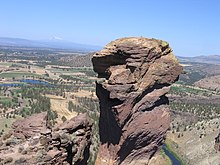Smith Rock State Park is an American state park in central Oregon's high desert near the towns of Redmond and Terrebonne.

Understand
[edit]The park's sheer cliffs of tuff and basalt are ideal for rock climbing of all difficulty levels. Smith Rock is generally considered the birthplace of modern American sport climbing, and is host to cutting-edge climbing routes. There is sport climbing, traditional climbing, multi-pitch climbing, and bouldering.
The park is dog-friendly but requires leashes at all times.
History
[edit]Landscape
[edit]
Flora and fauna
[edit]Climate
[edit]Get in
[edit]Fees and permits
[edit]- Daily use fee: $5
- Annual permit: $30
- Parking fees are $5 a day or $30 a month.
Day passes can be purchased from 3 machines- at the main parking lot by the visitor center, the bus/RV parking lot, and the Northern Point/ turnaround area. Bring exact change, or preferably credit cards (the turnaround fee station takes credit cards only, and is closed in winter due to freezing). Buy annual passes (12 or 24 months) at the visitor center yurt (when open-hours are variable), at Oliver Lemon’s Terrebonne (formerly Thriftway), or online.
Get around
[edit]See
[edit]Do
[edit]
The park contains the first U.S. climb rated 5.14. The area is well known for its challenging climbing routes so eventually all top climbers visit. In 1983, Allan Watts began to use sport climbing ethics which pushed American climbing to new levels. Shortly after, between 1992 and 2009, about 500 new climbing routes were added. This brought climbers from all over the world as Smith Rock became the world capital for sport climbing. To this day the park still attracts climbers from all over the world. The best time to visit is fall and late spring. The winter tends to be too cold (below freezing) and the summer months regularly reach the 100s °F (40s °C).
In addition to the world-famous rock climbing, Smith Rock State Park is host to many miles of hiking trails, the meandering Crooked River and views of the volcanic peaks of Oregon's Cascade Range.
Rock climbing
[edit]Smith Rock has over 1800 climbing routes.
Climbing Guide Service: Smith Rock Climbing School, ☏ +1 541-312-9242. 9 AM - 5 PM.
Hiking and mountain biking
[edit]There are miles of hiking and mountain biking trails where you can enjoy the views of the river and mountains. Watch climbers work their way up the famous "Monkey Face".
Buy
[edit]The visitor center in the yurt sells a few souvenirs as well as park annual passes. It is open limited hours, mostly on weekends, depending on seasonal demand and volunteer availability.
Eat
[edit]Drink
[edit]Lots of water. When hiking into the park from the main parking lot, the last water fountain is just before the bridge.
Sleep
[edit]The closest hotels are located in Redmond, 15 miles north of Bend.
Lodging
[edit]Camping
[edit]
There are two camping options available. One is in the park's bivouac area at the southern boundary of the park, while the other is the Skull Hollow Campground located several miles from the park. Camping at the bivouac is $5 per person, per day. There is hot water, showers, bathrooms, and many campsites to choose from. The park asks all bivouac users to keep all food out of campsites and in the communal kitchen area. Skull Hollow campground is 5 miles east of the park and runs along a Forest Service road. Although it is free, there is no running water and it is farther from the park. Fires are permitted but wood is scarce. Bring your own firewood. No reservations accepted.

